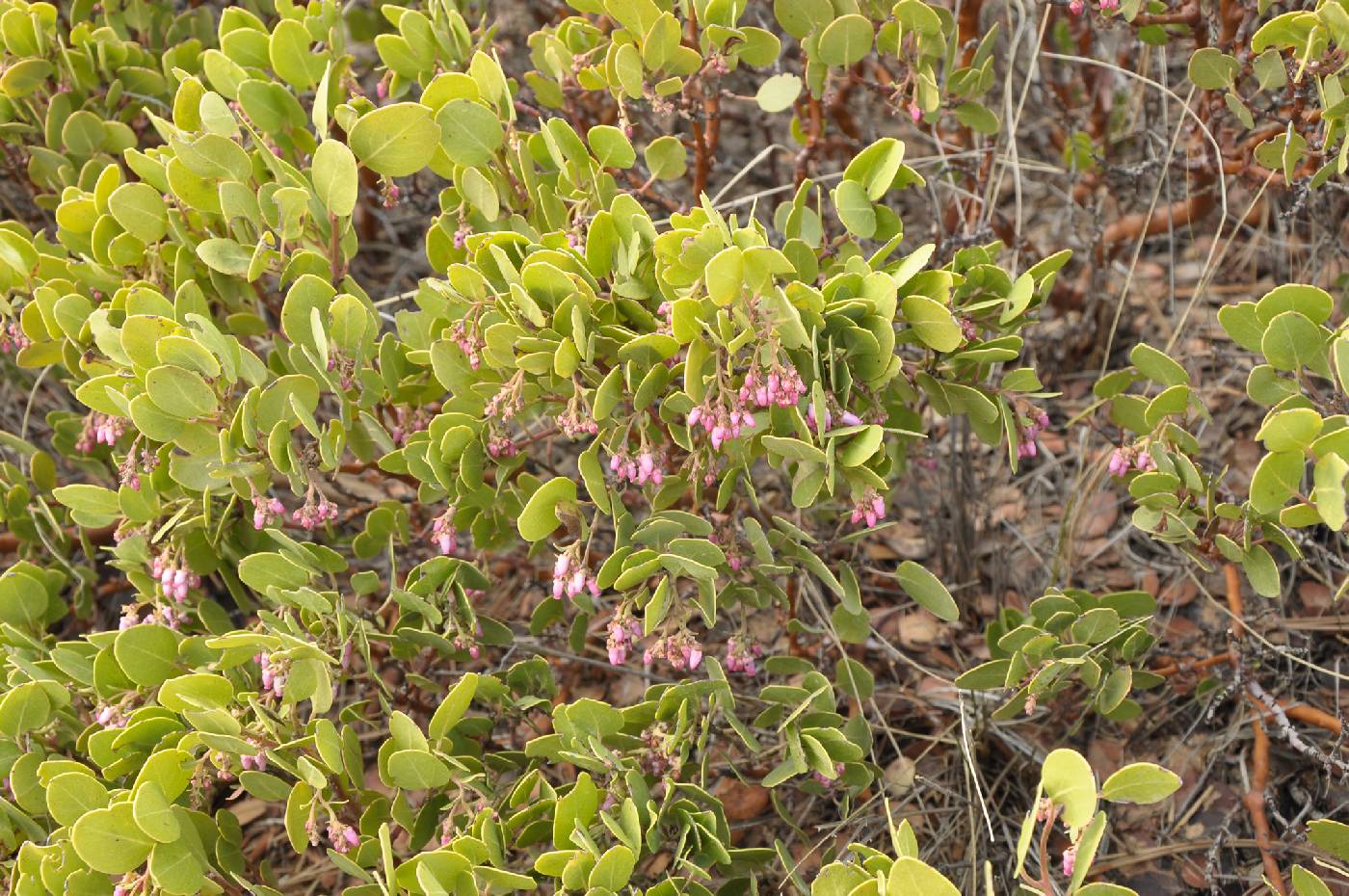
|
Family: Ericaceae |
Shrubs or trees, either burled and resprouting after fire or not burled and killed by fire; bark usually promptly exfoliating, reddish, (thin), or, sometimes, persistent, gray, rough, shredded (A. morroensis, A. nissenana, A. nummularia, A. osoensis, A. pajaroensis, A. rudis, A. tomentosa). Stems prostrate to erect, glabrous or hairy, sometimes glandular. Leaves (usually spreading, sometimes erect, sometimes overlapping when petiole is short), usually isofacial, sometimes bifacial in stomatal distribution (stomata present only on abaxial surface) and usually in color or pubescence (A. andersonii, A. crustacea, A. edmundsii, A. insularis, A. morroensis, A. nummularia, A. pajaroensis, A. pumila, A. sensitiva, A. tomentosa, A. uva-ursi); petiole absent or present; blade ovate to elliptic, coriaceous, margins entire (serrulate in A. pacifica, rarely so in young plants or resprouts, sometimes ciliate), usually plane, rarely revolute, surfaces (smooth to papillate or scabrous), hairy or glabrous. Inflorescences racemes or panicles (panicle branches racemelike), 5-20(-50)-flowered, (partially developing with new stem growth and dormant (immature inflorescences) for 6-9 months, usually pendent, can be erect when immature, pendent in flower; bracts persistent, (deciduous after flowering in A. pringlei), tan or light brown, scalelike, sometimes keeled, deltate or ovate, (tips often marcescent), or hue as in leaves, leaflike, narrowly lanceolate and flat, buds usually clustered, bracts imbricate, sometimes buds spread apart on axis, bracts not imbricate); bracteoles absent. Flowers bisexual; sepals persistent, 5 (4 in A. nummularia, A. sensitiva), distinct, ovate to deltate; petals 5 (4 in A. nummularia, A. sensitiva), connate nearly their entire lengths, white to pink, corolla conic to urceolate; stamens (8-)10, included; filaments dilated, (usually hairy at base); anthers (dark red), with 2 (recurved), dorsal awns, dehiscent by terminal pores; ovary 2-10-locular; stigma capitate. Drupes red, reddish brown, or brown, globose or depressed-globose, (exocarp coriaceous, rarely thin), smooth, (mesocarp usually dry, mealy, rarely absent, endocarp multiple-seeded); pyrenes 1-10, connate or not. Seeds 1-10, distinct or connate along radial faces of stony endocarp into 2s or 3s, sometimes connate into single sphere, (triangular-ovoid). x = 13. Arctostaphylos is richly diverse and taxonomically challenging. Unequivocal fossils appear as far back as the middle Miocene. Many pulses of diversification and decimation may have taken place in the genus since then; evidence suggests that there has been a rapid radiation in the last 1.5 million years. Some morphological features are not clearly differentiated among taxa and appear to be mosaically distributed. PLANT: Shrubs erect or prostate and mat-forming; bark usually reddish-brown, smooth. LEAVES: simple, evergreen, leathery; margins usually entire. INFLORESCENCE: terminal simple or few-branched racemes or dense panicles. FLOWERS: perfect, actinomorphic; sepals imbricate and distinct; corollas white to pink; stamens 10, included; anthers spurred; filaments dilated, hairy. FRUITS: berry-like drupes, fleshy. NOTES: 50-60 spp., mostly N. Amer., one circumboreal. (Greek arctos, bear, and staphyle, a bunch of grapes, fruits of A. uva-ursi eaten by bears). REFERENCES: John L. Anderson , 2008, Vascular Plants of Arizona: Ericaceae. CANOTIA 4 (2): 21-30. Fls 5-merous; cal saucer-shaped, the sep imbricate, distinct to the base; cor ovoid, the rounded lobes spreading or recurved; stamens 10; filaments pubescent, much-dilated below, much shorter than the cor; anthers subglobose, opening by 2 terminal pores and bearing 2 deflexed terminal awns; ovary 5-locular, conic-ovoid, subtended by a 10-lobed disk; style columnar; stigma capitate; ovules 1 per locule; fr a fleshy or mealy drupe with 5 bony nutlets; freely branched shrubs (ours low and creeping) with persistent, alternate lvs and white to pink fls in short, few-fld, terminal racemes. 45, mainly w. N. Amer. Gleason, Henry A. & Cronquist, Arthur J. 1991. Manual of vascular plants of northeastern United States and adjacent Canada. lxxv + 910 pp. ©The New York Botanical Garden. All rights reserved. Used by permission. |
This project was made possible in part by the Institute of Museum and Library Services [MG-70-19-0057-19].
Powered by Symbiota



